 Free Aptitude Test Practice Questions 2025
Free Aptitude Test Practice Questions 2025
An aptitude test is an assessment used to evaluate an individual's ability to perform specific tasks or skills. It's typically used in education and employment contexts. The term "aptitude" refers to the capability, talent, or innate Cognitive and Analytical Reasoning skills a person has for specific tasks.
Aptitude tests assess the following abilities:
- Verbal Reasoning includes Critical Thinking, Deductive Reasoning, Written Communication, and Reading Comprehension questions.
- Logical Reasoning (Non-Verbal) includes Abstract Reasoning, Inductive Reasoning, Diagrammatic Reasoning, and Spatial Reasoning questions.
- Logical Reasoning (Verbal) includes True/False/Cannot Say, Deduction, and Syllogism questions.
- Numerical Reasoning includes Basic Arithmetic, Mathematical Knowledge, Numerical Logic, and Word Problems questions.
- Mechanical Reasoning includes Mechanical Comprehension, Mechanical Knowledge, Electronics Knowledge, and Mechanical Tools questions.
- Situational Judgment includes job-related real-life situation questions that assess the candidate's decision-making abilities.
Companies and government organizations usually hire the services of test providers to perform pre-employment job aptitude tests that include a mix of various aptitude test questions. These include CCAT, SHL, Wonderlic, Watson Glaser, EIAT, Ramsay, CASPer, Predictive Index, Raven, and Revelian.
Contact us at c.serv@jobtestprep.com If you're not sure which test is relevant for your position.
Here you will find aptitude examples of a variety of aptitude question types along with detailed explanations about their use and how to approach and solve them.
Each example is designed to enhance understanding and improve problem-solving skills. Let’s begin.
Aptitude Test Practice
The main challenge with aptitude questions arises from the tight time limit and the diversity of skills tested, including abstract reasoning, numerical ability, verbal comprehension, problem-solving, and more.
Individuals may struggle depending on their personal strengths, weaknesses, and the type of aptitude test they are taking.
Try the following aptitude practice test to familiarize yourself with a diverse range of aptitude practice questions.
Verbal Reasoning Questions
A verbal reasoning question is a type of question that assesses your ability to understand and analyze written information. It typically involves a passage of text followed by one or more questions that require you to draw logical conclusions, make inferences, evaluate arguments, and identify assumptions.
Here are some Verbal Reasoning questions you can try:
Deductive Reasoning Aptitude Question
Company spokesmen report exclusively to the PR manager, unless the company is small, in which case they report directly and exclusively to the CEO. When company spokesmen report to the CEO, they sleep well at night.
Conclusion: Only those who sleep well at night are company spokesmen who work in small companies.
A. Conclusion follows
B. Conclusion does not follow
Answer:
Conclusion follows.
Company spokesmen in big company = A, report exclusively to the PR manager = B, report directly and exclusively to the CEO = C, can sleep well at night = D.
According to the premises, (A -> B), (~A -> C), and (C -> D), which means (~A -> D).
The conclusion states (only D -> ~A).
Notice the conclusion is a manipulation of the combination of premises. Compare (~A -> D) to (only D -> ~A): two operations were used – transposing and adding the word only. According to the NOT Triangle, the meaning stays the same.
There are several common deductive reasoning question types you'll likely see on your aptitude test, with the most common ones being syllogism (like the example question above) and seating arrangements. To learn how to answer such questions easily and increase your chances of acing the aptitude exam, visit our SHL Deductive Reasoning page, which includes more sample questions and a complete prep course.
Reading Comprehension Aptitude Question
"EUREKA- ARCHIMEDES' ANECDOTE"
According to a famous anecdote, Archimedes was required to determine whether the crown, made for King Heiro the second, was forged entirely of pure gold. The king, who supplied the gold himself, wanted to make sure the goldsmith did not substitute some of it with silver.
Since melting down the crown to calculate its density was not a viable option, Archimedes had to come up with a new method for measuring the crown's composition. Archimedes knew if he could measure the volume of the king's crown, and compare it with another crown, made of pure gold and of an identical weight, he'd be able to determine the crown's composition. Alas, at the time there was no known method for taking such a measurement.
One day, whilst attending one of the public bath houses, Archimedes noticed that as his body was slowly sinking into the bath, the level of water was rising, respectively. He realized he had found a way to measure an object's volume; the volume of the water that rose is equal to volume of the immersed body (in this case, his own). Bursting with enthusiasm about his discovery, he ran naked into the street shouting "Eureka!", Greek for "I have found it".
According to the passage, Archimedes wanted to calculate the crown's density since:
A. It is indicative of the crown's composition.
B. It is indicative of the amount of gold that has been substituted.
C. It can reveal how much of the king's gold had been used forging the crown.
D. It reveals the exact materials that make up the king's crown.
Answer:
The correct answer is (A).
According to the fourth paragraph, "…provide him with the crown's density, which in turn would reveal the true nature of the crown's composition." Density can be used to indicate the crown's composition, in terms of whether it is made of pure gold. However, it cannot supply us with further information, such as how much gold was substituted.
Therefore, the correct answer is (A).
Reading Comprehension questions require the ability to read and process large amounts of text within a limited time frame and the capacity to understand and draw conclusions when dealing with complex pieces of information. For more information, see our Reading Comprehension PrepPack.
Visit our MAP Assessment Test.
Written Communication Aptitude Question
Please identify which type of error appears in the sentence below, if any.
The drunk driver made a report that he was driving within the speed limit but he forgot to mention that he did not have a valid driver's license.
A. Grammar.
B. Spelling.
C. Punctuation and Capitalization.
D. No mistake.
Answer:
A comma should be used before the word "but" to connect the two independent clauses. The correct answer is C.
If you’re struggling with proper syntax, punctuation, and correct sentence structure practice will help you get better and improve your skills with Restatements, Information Presentation, and Paragraph Organization practice questions. For more information, see the SHL Verbal Reasoning page.
Critical Thinking Aptitude Question
Everyone who has been diagnosed with sleep apnoea has encountered a personal battle owing to the disease. For example, Vicki suffered from depression and lost her job, while Bill felt a strain on his marriage.
Proposed assumption: Vicki and Bill encountered a personal battle because they couldn’t come to terms with their disease.
A. Conclusion follows
B. Conclusion does not follow
Answer:
The correct answer is B (Conclusion does not follow).
It is plausible that the reason people who suffer from sleep apnoea encounter a personal battle is because of an inability to come to terms with this disease. However, since the passage does not provide an actual reason, you cannot reach this conclusion without reasonable doubt.
Critical thinking tests can have up to 5 major sections or sub-tests that assess and measure various aspects. To ensure you know how to ace these sections and increase your chances of passing your upcoming aptitude test, visit our Critical Thinking test guide, which includes a free sample test and a full practice course.
Additionally, you check out our Free Watson Glaser Practice Test.
Logical Reasoning Questions (Non-Verbal)
A non-verbal reasoning question is a type of question that assesses your ability to understand and analyze visual information without relying on language or verbal communication. It involves the interpretation and manipulation of visual patterns, symbols, shapes, figures, and diagrams.
Logical Reasoning refers to the ability to think critically, analyze information, and draw valid conclusions based on logical principles and patterns.
Here are some Non-Verbal Logical Reasoning Aptitude assessment questions you can try:
Inductive Reasoning Aptitude Question
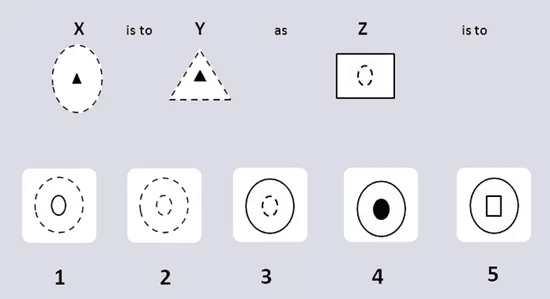
Answer:
The correct answer is 3.
The relationship between figure X and figure Y is as follows:
1) The outer shape of figure Y is the same as the inner shape of figure X.
2) The format of the outer shape of figure Y (dotted line) has the same format as the outer shape of figure X.
3) The inner shape does not change.
The correct answer must have the same relationship with figure Z.
Answers 1, 4 and 5 can be eliminated as they show a change to the inner shape.
Answer 2 can be eliminated as the outer shape is in a different format than that of the outer shape in figure Z. In other words, the outer shape in figure Z has a solid line, so the outer shape of the correct answer must also have a solid line.
We are left with answer 3, which is the correct answer, as the outer shape takes on the form of the inner shape in figure Z, i.e. it becomes a circle, the format of the outer shape is the same format as that of figure Z (solid line), and the inner shape does not change.
On inductive reasoning tests, you'll usually see diagrams and be asked to spot the logical pattern, possibly using verbal, abstract, and/or mechanical reasoning. Inductive reasoning tests are taken by job-seekers in all fields and at all levels. To try more sample questions and access the complete practice course for inductive reasoning aptitude tests, visit our in-depth SHL Inductive Reasoning Practice. You can also learn about the SHL General Ability (Verify G+) Test which contains both inductive and deductive reasoning.
Abstract Reasoning Aptitude Question
Look at the two sets of shapes. Then determine whether a test shape belongs in Set A, Set B or neither.
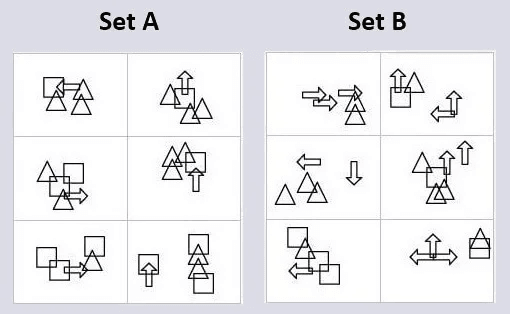
The following test shape belongs to:

A) Set A
B) Set B
C) Neither
Answer:
The correct answer is (A).
Set A: If the arrow points upwards, it crosses only the square. If it points to any other direction it crosses both the square and the triangle.
Set B: One type of shape (triangle, arrow, etc.) appears 3 times.
The test shape belongs to set A, since the arrow points upwards and crosses the square.
Abstract reasoning is highly correlated to cognitive aptitude. That's why almost any cognitive aptitude test includes abstract questions. To improve your abstract reasoning skills and try realistic abstract practice tests from the most common tests, visit our Abstract Reasoning Practice Guide.
Spatial Reasoning Aptitude Question
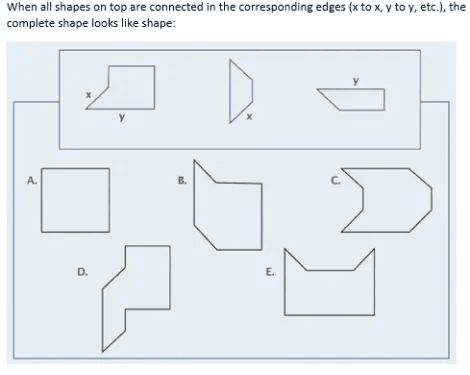
The answer is B.
Spatial reasoning tests (or "spatial awareness tests") can be challenging, especially since most candidates aren't used to solving such questions and it requires some practice to master the solving techniques. To improve your solving skills, try more sample questions, and access the complete spatial reasoning practice course, visit our Spatial Reasoning Practice Guide.
Diagrammatic Reasoning Aptitude Question

A. = JLOO
B. = JJLO
C. = JJOL
D. = LOO
Answer:
The correct answer is A.
The aim is to understand rule 3. To do so, first determine the rule for 2 and 1.
First, look at the - TI - TTI – section. Since TI becomes TTI when applying rule 2, this means that rule 2 commands you to duplicate the first letter. Since QPRG becomes QQPGR when applying rules 1 and 2, and we know that rule 2 commands you to duplicate the first letter, we can conclude that rule 1 commands you to swap the last two letters.
QPRG becomes QPRGG when applying both rules 3 and 1. We already know that rule 1 commands you to swap the last two letters. We can therefore conclude that rule 3 commands you to double the last letter (rule 1 doesn’t change the result, because the last letter is doubled first and then swapped).
Since rule 3 commands you to double the last letter, the last letter JLO becomes JLOO.
Some diagrammatic reasoning questions can be extremely challenging if you encounter them for the first time on your job aptitude test. To eliminate the element of surprise and ensure you know how to solve such questions quickly and accurately, visit our Logical Reasoning Practice Prep, which includes practice tips and a full prep course.
Logical Reasoning Aptitude Question (Verbal)
Verbal Logical Reasoning refers to the ability to think critically, analyze information, and draw valid conclusions based on logical principles and patterns. Verbal Logical questions include True/False/Cannot Say, Deduction, and Syllogism.
Here is a verbal Logical Reasoning question you can try.
Three travelers - John, Kate, and Lenny - came back from three trips to the following countries: Mauritania, Nepal, Oman, Peru and Qatar. The countries each of them visited must be consistent with the following rules and conditions:
- Each country was traveled by at least one of the travelers.
- Each traveler took only one trip, during which he or she traveled to only two or three different countries.
- Only one traveler traveled to Qatar.
- Every traveler who traveled to Mauritania also traveled to Nepal.
- A traveler who traveled to Qatar did not travel to Peru.
- John traveled to all the countries Kate traveled to.
Which one of the following could be a complete and accurate list of the countries Lenny traveled to?
A. Mauritania, Nepal, Oman.
B. Oman, Qatar, Peru.
C. Nepal, Oman, Qatar.
D. Qatar, Mauritania, Oman.
E. Mauritania, Nepal.
The correct answer to this question is the only response that does not violate any of the rules. In particular - every country must be visited at least once without any of the travelers visiting less than 2 and more than 3 countries.
(A) If this is the correct answer, then John must have traveled to Qatar and Kate to Peru. But if Kate travels to Peru then John must also travel to Peru - a violation of the rules (q → ~p).
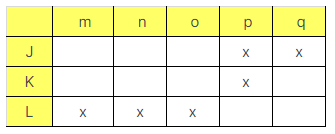
(B) This response violates one of the rules (q → ~p) and therefore it is not the correct answer.
(C) If this is the correct answer, then between John and Kate - Peru and Mauritania must be visited.
A possible setup could be:
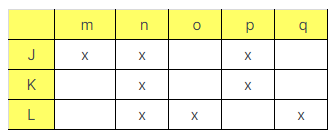
Logical reasoning questions may come in a non-verbal form - abstract, diagrammatic, inductive, and in verbal form - True/False/Cannot Say, Deduction, and Syllogism. To get thorough practice for any of these types and increase your chances of acing your upcoming aptitude exam, visit our Logical Reasoning Test Prep.
Numerical Reasoning Aptitude Question
Numerical Reasoning refers to the ability to understand and analyze numerical information in order to solve problems and make informed decisions. Numerical reasoning questions typically involve mathematical operations such as addition, subtraction, multiplication, division, percentages, ratios, averages, and interpreting graphs, charts, and tables.
Here is one Numerical question we can try.
There is a circular outdoor ice skating rink. The machine that prepares the rink for skating at the start of the day prepares 600 square feet of rink every hour. If the circumference of the rink is 200 feet.
Approximately how many minutes does it take the machine to prepare the entire rink for skating at the beginning of each day?
A. 5.
B. 32.
C. 64.
D. 318.
E. 3183.
Answer:
The correct answer is approximately 318 minutes.
C = 2*π*r. If the circumference of the rink is 200 feet, then the radius of the rink is 100/π.
A = π*r2, therefore the area of the rink is 10000/π.
If the machine prepares 600 square feet every hour, then it takes (10000/π)/600 = 50/3π hours in order to prepare the entire rink. Multiply this result by 60 to convert from a number of hours to a number of minutes: (50*60)/3π = 1000/π.
Since π≈3.14, the correct answer must be 318 minutes.
Numerical reasoning questions can be challenging due to several factors: a lack of confidence in dealing with numbers, the need for complex problem-solving, time pressures, and the need for multistep calculations. Want to practice more Numerical Reasoning questions? See the Numerical Reasoning Practice page.
Mechanical Reasoning Aptitude Question
Mechanical reasoning refers to the ability to understand and apply principles of mechanics and physics in order to solve problems related to mechanical systems, machinery, and physical forces.
Challenge your mechanical skills with the following question.
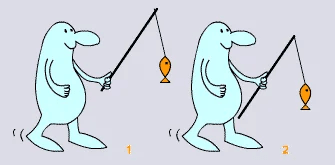
A) 1
B) 2
C) Both have to apply equal force
D) There is not sufficient data
Answer:
The correct answer is (A).
A lever is a long, rigid beam or bar used to lift heavy weights, allowing to apply less force for a longer distance in order to move a weight around a fixed pivot. A lever consists of three parts:
Fulcrum - the fixed point at which the lever pivots (usually marked as a triangle)
Load - load is the weight or resistance that is moved by the lever.
Effort arm - the amount of force required to the work, i.e., the force used to push down or pull up the lever to move the load.
There are 3 types of levers, classified according to the placement of the fulcrum, load and effort.
Class 1 - the fulcrum is located between the applied force and the load, e.g. a crowbar or a pair of scissors.
Class 2 - the load is situated between the fulcrum and the force, e.g. a nutcracker.
Class 3 - the force is applied between the fulcrum and the load, e.g. tweezers.
In this question, the fisherman rod is a class 3 lever in which the effort is between the fulcrum and the load. The fulcrum is the end of the fishing rod (the end without the fishing line), the load is the fish, and the effort is the force applied by the fisherman. It is the position of the effort required to lift the fish that changes between the two figures.
Since the work (or more precisely, torque) is constant, the longer the distance between the effort and the fulcrum, the easier it is to lift the load because the force required to do work is distributed over a longer distance.
Therefore, (A) is the correct answer, since, in this figure, the fisherman applies his effort at a shorter distance from the fulcrum and hence has to pull his fishing rod harder.
Most Mechanical Reasoning Aptitude tests require a deep understanding of mechanical, electrical, and maintenance subjects. Some will also assess your spatial reasoning and math skills. To improve your skills and knowledge in these areas and enhance your chances of passing the test, visit our Mechanical Reasoning Test Page, which includes a free practice test, sample questions, and a full practice course.
Common Mechanical Reasoning Assessments include the SHL Mechanical Comprehension, IBEW Test, Ramsay Mechanical Test, and Bennet Mechanical Test.
Situational Judgment Aptitude Question
Situational judgment refers to the ability to assess and respond appropriately to various situations or scenarios that you may encounter in real-life or work-related settings.
Try to solve the following scenario.
You manage a department that includes 10 employees who work with customers, and a supervisor. You notice that one of the employees is regularly late arriving in the morning.
What would you do?
A. Nothing. You trust the supervisor - she works closely with the team members and is probably aware of the situation and it's under her control.
B. Talk to the employee next time you see him arrive late.
C. Ask the supervisor if she's aware of this situation.
D. Tell the supervisor that she should pay more attention to her employees' arriving hours, as it looks bad.
Answer:
Best response: C
This question assesses your understanding of your position as a manager in terms of the chain of command. Be aware that different workplaces prefer different levels of managerial involvement versus keeping of the chain of command; we recommend that you read about your potential workplace and position before taking the test.
Response A is a “do nothing” response. This kind of response is passive and is rarely the best course of action. Although it may be likely that the supervisor is aware of the situation, you can’t assume it. This response fails to supervise employees’ performance.
Talking to the employee yourself (response B) ignores the supervisor’s authority and responsibility (chain of command). You want to take action, but not to undermine the supervisor.
In response C you take action which is appropriate for someone in your position – you bring the situation to the supervisor’s awareness and allow her to handle it as she sees fit. This is the best response in this situation.
In response D you reprimand your supervisor for the employee’s actions. You don’t trust the supervisor’s skills and judgment, and don’t provide her the authority to handle the situation her way, and don’t provide her a chance to explain her point of view – you don’t know if she is aware of the situation or if there are any special reasons for it (effective communication).
Situational Judgement Tests have become highly popular in recent years, and even huge employers, such as Amazon and Procter & Gamble, have started using them to screen their candidates. To get a better understanding of situational question types, take a free SJT sample test, or visit our In-Basket Prep Guide.
Create Your Own Assessment Prep Kit!
Finding a job can be a lengthy and challenging journey, often stretching over months and requiring multiple pre-employment tests and interviews. With our Premium Membership, you'll have the support you need every step of the way.
Mix & match 3 Preparation Packs at 50% discount for 1,3, or 6 months
Civil Service Aptitude Tests
The following list includes some of the civil service government organizations that use aptitude exams as part of their admission process.
ASVAB Aptitude Test
The Armed Services Vocational Aptitude Battery (ASVAB) is an aptitude assessment that measures cognitive skills and abilities which help predict future academic and occupational success in the military. The exam includes a mix of Verbal, Numerical, and Mechanical questions.
For more information about the assessment see our Free ASVAB Practice Page.
IBEW Aptitude Test
The IBEW Aptitude Test, a time-bound, multiple-choice examination, is a necessary requirement for anyone aspiring to embark on an electrician apprenticeship.
The Exam includes a mix of Mechanical, Verbal, and Numerical aptitude questions
For more information about the assessment see our free IBEW Practice Guide.
TSA Aptitude Test
The TSA CBT test serves as one of the initial challenges you'll encounter when charting a career path in the Transportation Security Administration. The exam includes a mix of Verbal Reasoning and X-Ray questions.
For more information about the assessment see the TSA CBT Prep Page.
USPS Aptitude Tests
The USPS aptitude tests consist of 4 different exams that measure the skills and abilities of applicants for various positions in the USPS, such as mail carriers, mail processing clerks, mail handlers, and sales, services, and distribution associates.
The exam includes various aptitude tests that are unique to USPS such as Work Scenarios and Verify Customer Information alongside different personality exams.
For more information about the assessment see our Free USPS Practice Page.
ATSA Aptitude Test
The ATSA Test, or Air Traffic Skills Assessment, is a preliminary employment examination administered by the FAA for individuals pursuing a career as Air Traffic Controllers (ATCs).
The exam includes a mix of Verbal, Non-Verbal, and Logical Reasoning questions.
For more information about the assessment see our free ATSA Exam Prep Guide.
FAQs
"Aptitude" is a term often used in psychology, education, and human resources to refer to a person's natural ability or potential for learning and performing certain tasks or skills. It represents the capacity or potential of an individual to acquire knowledge or skills, given the proper resources and learning environment.
This ability is thought to be inherent or inborn, though it can be developed and improved over time with training and practice. It is often measured with aptitude tests, which are designed to assess one's abilities in specific areas.
An Aptitude test (Also known as a Career Path test ) is a career test for adults used to understand a person's ability to perform or learn specific tasks. These tests don't focus on knowledge or skills that a person already has, but rather on their potential to learn and succeed in certain areas.
The goal is to predict how well a person will perform in a certain job or field based on these inherent abilities.
There are two main ways aptitude tests are utilized:
- Career Guidance - These tests aid individuals in exploring various career paths and pinpointing a profession that aligns well with their abilities and passions.
- Screening Job Applicants - Employers utilize aptitude tests to evaluate prospective employees, identifying those who demonstrate the potential to thrive in a specific role.
A career aptitude test for adults serves as a useful instrument that assists individuals in uncovering their talents, passions, and personality attributes.
By doing so, it helps them identify suitable professions that align with their unique qualities. These tests are often accessible online and can be completed within a relatively short span of time.
Though there is a multitude of career aptitude tests designed for adults, most measure similar key aspects:
- Interests: They delve into what excites and inspires you, and which activities you derive enjoyment from.
- Skills: They gauge your strengths and capabilities, assessing the unique talents you possess.
- Personality: They explore your values and predilections and consider how you engage with others.
There are various free career tests on the web you can try.
"Aptitude" is a term often used in psychology, education, and human resources to refer to a person's natural ability or potential for learning and performing certain tasks or skills. It represents the capacity or potential of an individual to acquire knowledge or skills, given the proper resources and learning environment.
This ability is thought to be inherent or inborn, though it can be developed and improved over time with training and practice. It is often measured with aptitude tests, which are designed to assess one's abilities in specific areas.
Aside from aptitude tests, most employers include one or several interviews throughout their hiring process. Pre-recorded video interviews, such as HireVue's, have become highly popular in recent years. Visit our pre-recorded interview page to learn more about how to prepare for them.
If you are looking for a different test, or are not sure which test is relevant for your position, please contact us at c.serv@jobtestprep.com and we will do our best to ensure you get the most accurate preparation for your upcoming assessment.


